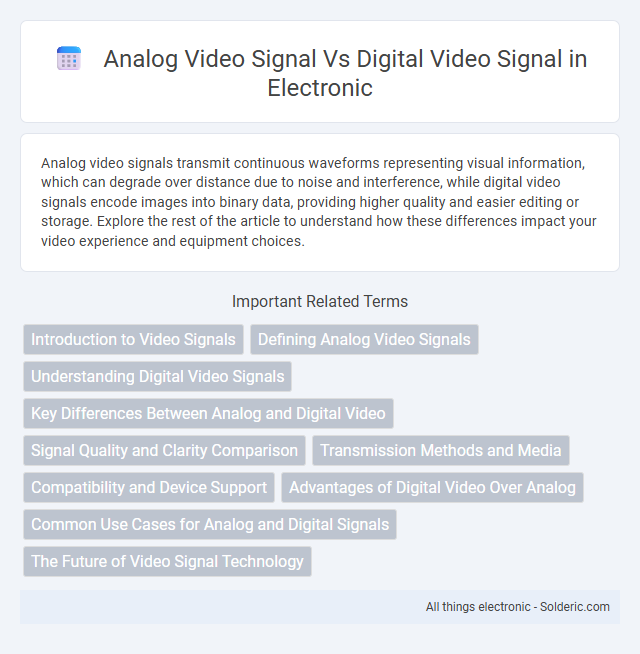Analog video signals transmit continuous waveforms representing visual information, which can degrade over distance due to noise and interference, while digital video signals encode images into binary data, providing higher quality and easier editing or storage. Explore the rest of the article to understand how these differences impact your video experience and equipment choices.
Comparison Table
| Feature | Analog Video Signal | Digital Video Signal |
|---|---|---|
| Signal Type | Continuous electrical waveform | Discrete binary data (0s and 1s) |
| Quality | Prone to noise and degradation | High quality, less noise interference |
| Storage | Requires analog tape or similar media | Stored in digital files (e.g., MP4, AVI) |
| Transmission | Subject to signal loss and interference | Robust, uses error correction techniques |
| Compatibility | Works with older equipment (VCR, CRT TVs) | Compatible with modern digital devices |
| Editing | Complex, typically analog methods required | Easy with software-based digital tools |
| Bandwidth | Lower bandwidth usage | Higher bandwidth due to data rates |
| Examples | Composite video, S-Video | HDMI, DisplayPort, digital streaming |
Introduction to Video Signals
Analog video signals transmit continuous waveforms representing varying light intensities, while digital video signals encode visual information as discrete binary data for enhanced precision and noise resistance. Digital signals enable efficient compression, storage, and transmission, supporting high-definition formats and advanced video processing techniques. Understanding these fundamental differences helps you optimize video quality and compatibility across modern multimedia devices.
Defining Analog Video Signals
Analog video signals transmit continuous waveforms that directly represent visual information through variations in voltage or current, capturing real-time images with smooth gradation. These signals encode color, brightness, and synchronization in electrical pulses, commonly used in traditional television systems and VHS tapes. Understanding your display device's compatibility with analog signals is essential for optimal video performance and preserving image quality.
Understanding Digital Video Signals
Digital video signals represent visual information using binary code, allowing for higher quality and easier manipulation compared to analog signals, which rely on continuous waveforms subject to degradation. Understanding digital video signals involves recognizing their advantages in noise resistance, compression capabilities, and compatibility with modern devices. Your ability to work effectively with video technology improves significantly by mastering digital signal concepts and formats such as HDMI, MPEG, and MP4.
Key Differences Between Analog and Digital Video
Analog video signals transmit continuous waveforms representing images, which are susceptible to noise and degradation over distance, resulting in lower image quality. Digital video signals encode images as binary data, ensuring higher resolution, consistent quality, and easier compression for efficient storage and transmission. Your choice between analog and digital video significantly affects compatibility with modern devices and overall viewing experience.
Signal Quality and Clarity Comparison
Analog video signals often suffer from signal degradation and noise interference, resulting in lower clarity and reduced image sharpness over longer transmission distances. In contrast, digital video signals maintain consistent quality by encoding data into binary form, allowing error correction and preserving image fidelity regardless of cable length. Consequently, digital video provides superior signal clarity and resolution, making it the preferred choice for high-definition video applications.
Transmission Methods and Media
Analog video signals transmit continuous waveforms through coaxial cables or RF signals, which are prone to noise and signal degradation over long distances. Digital video signals use discrete binary data transmitted via fiber optics, HDMI, or Ethernet cables, ensuring higher quality, less interference, and easier integration with modern digital devices. You benefit from digital transmission's robustness and flexibility, especially in complex networked environments.
Compatibility and Device Support
Analog video signals offer broad compatibility with older devices such as CRT televisions and VCRs due to their continuous signal nature, making them ideal for legacy systems. Digital video signals require compatible digital interfaces like HDMI or DisplayPort, which provide higher resolution and enhanced features but may face compatibility issues with outdated equipment without adapters. Device support for digital signals spans modern TVs, computers, and gaming consoles, ensuring superior quality and functionality across contemporary multimedia platforms.
Advantages of Digital Video Over Analog
Digital video signals offer superior image quality with higher resolution and less degradation over distance compared to analog signals. They enable efficient compression, allowing for reduced storage space and faster transmission with minimal loss of data integrity. Furthermore, digital video supports advanced features such as error correction, encryption, and easy integration with modern multimedia platforms and devices.
Common Use Cases for Analog and Digital Signals
Analog video signals are commonly used in traditional broadcasting, CCTV systems, and older televisions where continuous signal variations provide a simpler and cost-effective transmission method. Digital video signals dominate modern applications such as streaming services, Blu-ray players, and HD broadcasting due to their superior quality, error correction capabilities, and ease of integration with computer networks. Your choice between analog and digital video signals should consider the specific requirements for video quality, compatibility, and transmission infrastructure.
The Future of Video Signal Technology
The future of video signal technology is rapidly shifting towards digital video signals due to their superior image quality, compression capabilities, and resistance to signal degradation. Digital signals enable higher resolutions like 4K and 8K, support advanced features such as HDR, and integrate seamlessly with internet streaming platforms, enhancing Your viewing experience. Analog video signals are becoming obsolete as digital formats provide more efficient transmission, storage, and editing options crucial for modern multimedia applications.
analog video signal vs digital video signal Infographic

 solderic.com
solderic.com